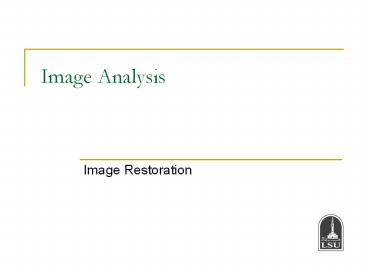Image Analysis - PowerPoint PPT Presentation
Title:
Image Analysis
Description:
Image Analysis Image Restoration Image Restoration Noise Models Noise Models Noise Models Noise Models Restoration When There is Only Noise Restoration When There is ... – PowerPoint PPT presentation
Number of Views:202
Avg rating:3.0/5.0
Title: Image Analysis
1
Image Analysis
- Image Restoration
2
Image Restoration
Image enhancement tries to improve subjective
image quality. Image restoration tries to recover
the original image.
3
Noise Models
- Noise may arise during image due to sensors,
digitization, transmission, etc. - Most of the time, it is assumed that noise is
independent of spatial coordinates, and that
there is no correlation between noise component
and pixel value. - Noise may be considered as a random variable,
its statistical behavior is characterized by a
probability density function (PDF).
Gaussian noise
4
Noise Models
Uniform noise
Impulse (salt-and-pepper) noise
5
Noise Models
Original
Noisy images and their histograms
6
Noise Models
- How to estimate noise parameters?
- If imaging device is available
- Take a picture of a flat surface.
- See the shape of the histogram decide on the
noise model. - Estimate the parameters. (e.g., find mean and
standard deviation.) - When only images already generated are available
- Get a small patch of image with constant gray
level - Inspect histogram
- Estimate the parameters
7
Restoration When There is Only Noise
- Low-Pass Filters
- Smoothes local variations in an image.
- Noise is reduced as a result of blurring.
- For example, Arithmetic Mean Filter is
? Convolve with a uniform filter of size m-by-n.
8
Restoration When There is Only Noise
- Adaptive, local noise reduction filter
- Let be the noise variance at
(x,y). - Let be the local variance of
pixels around (x,y). - Let be the local mean of pixels
around (x,y).
- We want a filter such that
- If noise variance is zero, it should return
g(x,y). - If local variance is high relative to noise
variance, the filter should return a value close
to g(x,y). (Therefore, edges are preserved!) - If two variances are equal, the filter should
return the average of the pixels within the
neighborhood.
9
Restoration When There is Only Noise
10
Restoration When There is Only Noise
- Median Filter
- Replaces the value of a pixel by the median of
intensities in the neighborhood of that pixel. - Is very effective against the salt-and-pepper
noise.
11
Restoration When There is Only Noise
- Adaptive Median Filter The basic idea is to
avoid extreme values - Let
- z_min minimum gray level value in a neigborhood
of a pixel at (x,y). - z_max maximum gray level value
- z_med median
- z(x,y) gray level at (x,y).
- Is z_medz_min or z_medz_max? (That is, is
z_med an extreme value?) - No
- Is z(x,y) an extreme value? (Is z(x,y)z_min or
z(x,y)z_max?) - No Output is z(x,y)
- Yes Output is z_med.
- Yes Increase window size (to find a non-extreme
z_med) and go to the first step. (When a maximum
allowed window size is reached, stop and output
z(x,y).)
12
Restoration When There is Only Noise
13
Restoration When There is Only Noise
Removing Periodic Noise with Band-Reject Filters
Spikes are due to noise
Periodic Noise
Band-reject filter
14
Restoration When There is Only Noise
Finding Periodic Noise from the Spectrum and
Using Notch Filters
Filter out these spikes
Noise due to interference
15
Image Restoration
Spatial domain
Frequency domain
16
Image Restoration
Inverse Filtering
This could dominate signal.
17
Image Restoration
18
Image Restoration
Cut off the inverse filter for large frequencies.
(Signal-to-noise ratio is typically low for large
frequencies.)
19
Image Restoration
- Minimum Mean Square Error (Wiener) Filtering
- Find such that the expected
value of error is minimized
- Solution is
Investigate this equation for different
signal-noise ratios.
20
Original image
21
Image Restoration
22
Least Squares Filtering
Find F(u,v) that minimizes the following cost
function
The solution is
(Unconstrained solution)
(See the derivations in the classroom)
23
Least Squares Filtering
Find F(u,v) that minimizes the following cost
function
Choose a P(u,v) to have a smooth solution. (A
high-pass filter would do the trick.)
24
Least Squares Filtering
The frequency domain solution to this
optimization problem is
(Constrained solution)
where P(u,v) is the Fourier Transform of p(x,y),
which is typically chosen as a high-pass filter.
Example
25
Least Squares Filtering































